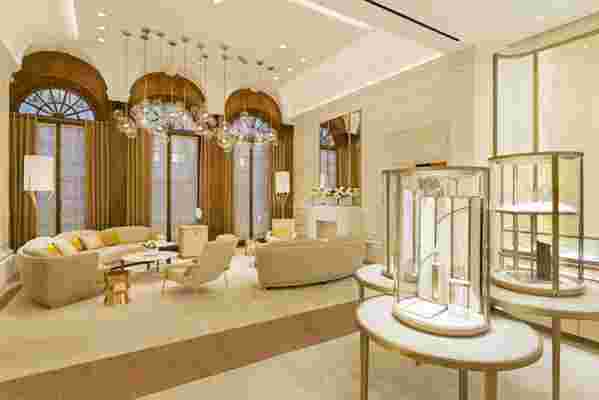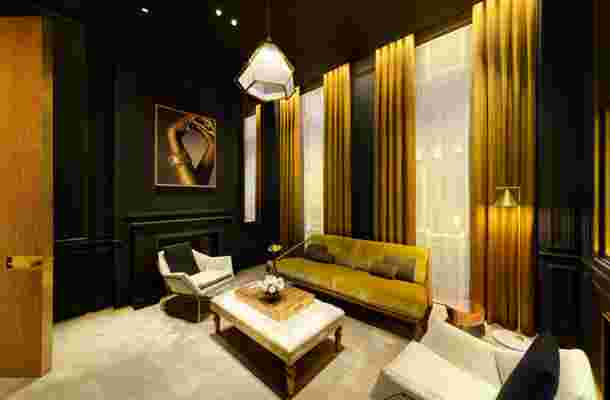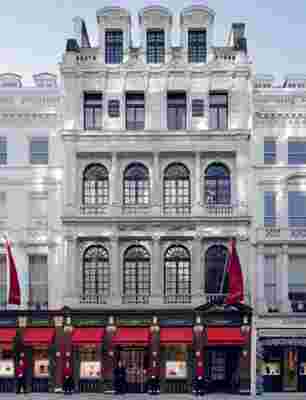The special political and social relationship between France and Great Britain has long been known as the Entente Cordiale. For proof of this close partnership, one needs to look no further than the history of the French jewelry brand Cartier. In 1902, it opened its first international outpost in London at the special request of the then Prince of Wales. Over the course of the next century, the ties between the French brand and British culture were tightly interwoven—all the way through from the “bright young things” of the 1920s to the Swinging Sixties to leading events in the social calendar today. It remains the only foreign jeweler to have a Royal Warrant.
Cartier’s standing as an “honorary Brit” has been celebrated this week as it reopens its store on London’s Old Bond Street. The boutique is dedicated to the customer experience, where clients can come for repairs or customization in a more intimate setting. Designed by regular collaborator Bruno Moinard at 4BI & Associates, it pairs with Cartier’s main flagship just steps along New Bond Street that reopened in late 2018. Earlier this week, the launch was marked with a series of talks featuring British creative greats such as model Twiggy, set designer Es Devlin, and menswear star Grace Wales Bonner in a program that highlighted this historic relationship. “London is so buoyant and full of creativity,” explains Pierre Rainero, image, style, and heritage director at Cartier. “It has a power of attraction that is huge.”

The “prestige floor” at the recently opened flagship on New Bond Street.

A private salon in the New Bond Street location.
When the original flagship on New Bond Street—Cartier’s London home since 1909—was renovated last year, the shop floor was dramatically enlarged and the offices and atelier relocated. “We decided to enlarge the space dedicated to our clients,” says Rainero, sitting in one of the six “salons” dedicated to peaceful, private browsing. “We needed to receive our clients in the way they deserve it. It’s a question of intimacy between a piece and a person. We are at the service of that—for clients to take their time and to be comfortable at what we do.”
The dedicated customer service areas were then moved to the new Old Bond Street site. One of the most exciting offerings at the venue is a two-hour session with a Cartier designer to craft a bespoke monogram. If one is in need of inspiration, there is a series of cabinets displaying highlights from the Cartier archive including a gift from the Duke of Westminster to Coco Chanel in 1924 (marked C) and a gold clip exchanged between infamous Parisian expats Wallis Simpson and the Duke of Windsor, emblazoned WE. Cross-Channel relations noted.

The imposing façade of Cartier's historic London flagship boutique.
A mood board evocative of the London flagship's refreshed design scheme.
The Old Bond Street store design is bright and crisp, and pays homage to the brand’s legacy in special details such as the panther, Cartier’s emblem, on the plaster bas-relief. The grander, palatial New Bond Street store has a similar atmosphere brought alive by commissioned works. In the men’s area is a Cubist chandelier by Studio Drift containing dandelions designed to symbolize speed (dandelion petals blow in the wind) and Cartier’s automotive links. In the central room, a series of pendant lights hangs that looks like a troop of ladies’ hats at the races. Upstairs, counterbalancing the generally light tones, the Salon Jacques Cartier is a rich, dark jewelry box of a room designed in black and gold.
Reinforcing the important relationship between old and new for Cartier, the wonderfully ornately carved original staircase—created long before the brand moved in—is left intact. “Within one of the most emblematic boutiques in Cartier’s history, in an iconic street in London, we managed to propose and design a place of modernity that is respectful of heritage,” says Claire Bétaille of 4BI & Associates.
The ultimate resource for design industry professionals, brought to you by the editors of Architectural Digest
Together the two addresses combine to create what Cartier describes as its “temple” retail concept that is more similar to a private maison than a store. As it should be, says Rainero. “Most clients at Cartier come for an experience,” he explains. “It is something they dream about, which they expect—and will want—to always remember.” Indeed, this new destination should enhance cordial relations for decades to come.
